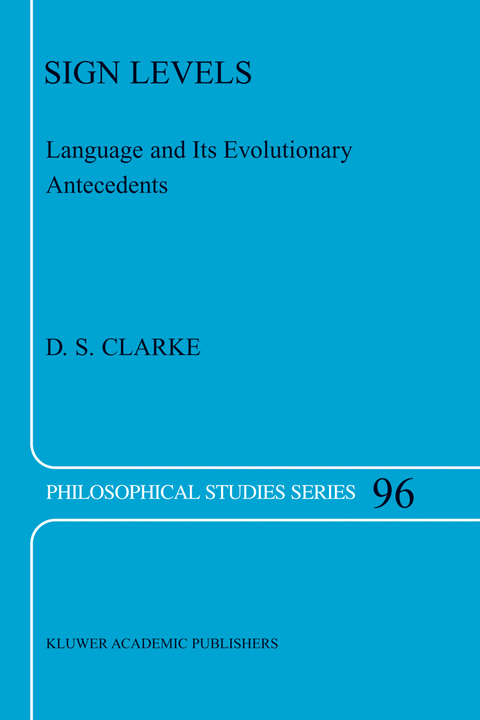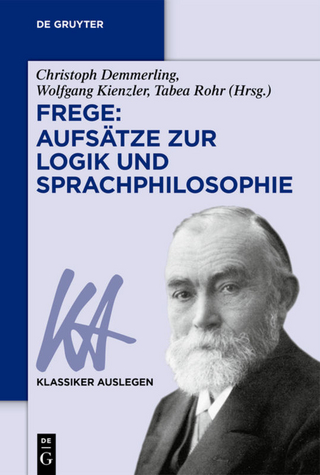
Sign Levels
Springer-Verlag New York Inc.
978-1-4020-3079-6 (ISBN)
Since the revolution in philosophic method that began about a century ago, the focus of philosophic attention has been on language as used both in daily conversation and in specialized institutional activities such as science, law, and the arts. But language is an extremely complex and varied means of communication, and the study of it has been increasingly incorporated into such empirical disciplines as linguistics, psycho linguistics, and cognitive psychology. It is becoming less clear what aspects of language remain as proper subjects of philosophical study, what are to be "kicked upstairs" (J. L. Austin's phrase) to the sciences. This work is a study of those logical features of language that remain central to philosophy after completion of kicking up. It conducts this study by describing similarities and differences between signs at differing levels, starting with natural events as primitive signs in the environments of their interpreters, and proceeding to pre linguistic signaling systems, elementary forms of language, and finally to the forms of specialized discourse used within social institutions. The investiga tion of comparative features requires isolating basic mental capacities that are present in the most primitive forms of organisms capable of sign interpretation. The problem then becomes one of tracing the emergence from these capacities of such categories as substance, attribute or quality, and quantity that we apply to natural languages. The study of sign levels is thus the construction of a genealogy of logical categories marking the develop ment of natural languages.
One. Three Ideals of Modern Philosophy.- 1.1 Simplicity and Certainty.- 1.2 Compositional Semantics.- 1.3 Simplicity and Comprehensiveness.- Two. The Methodology of Semiotic.- 2.1 Primitiveness and Sign Levels.- 2.2 Semiotic and Semiotics.- 2.3 Necessary and Contingent Features.- 2.4 The Language Archetype.- 2.5 Grades of Involvement.- Three. Signs and Learning Theories.- 3.1 Conditioned Reflex and Instrumental Learning.- 3.2 Behavioral and Teleological Reductions.- 3.3 Natsigns.- 3.4 Awareness of Associationist Learning.- 3.5 Proto-Natsigns and Panpsychism.- Four. Communicative Intent and Conventionality.- 4.1 Comsigns and Signals.- 4.2 Transactional and Iconic Aspects.- 4.3 Regularities and Conventions.- 4.4 Truth and Falsity.- Five. Proto-Language Sentences.- 5.1 Subjects and Predicates.- 5.2 Reference and Existence.- 5.3 Feature-Placing Sentences and Identification.- 5.4 Illocutionary Force and Avowals.- 5.5 Addresses.- 5.6 Frames and Semantic Fields.- Six. Natural Language Discourse.- 6.1 Linking Expressions.- 6.2 Reference, Meaning Transfer, and Fiction.- 6.3 Inferences and Propositions.- 6.4 Quotation and Interpretation.- 6.5 Identity.- Seven. Specialized Discourse.- 7.1 Writing and Institutional Specialization.- 7.2 Discourse Frames, Objects, and Existence.- 7.3 Discourse Relativity and Truth.- 7.4 Scientific Realism.- 7.5 Natural Kinds and Reference.- 7.6 Customs, Imperatives, and Laws.- Eight. Applications to Metaphysics.- 8.1 Philosophy and Metaphysics.- 8.2 Identity and Functionalist Theories.- 8.3 Beliefs and Persons.- 8.4 Sign Level Comparisons and Metaphysics.- Notes.- References.
| Erscheint lt. Verlag | 20.10.2004 |
|---|---|
| Reihe/Serie | Philosophical Studies Series ; 96 |
| Zusatzinfo | XI, 260 p. |
| Verlagsort | New York, NY |
| Sprache | englisch |
| Maße | 155 x 235 mm |
| Themenwelt | Geisteswissenschaften ► Philosophie ► Logik |
| Geisteswissenschaften ► Philosophie ► Sprachphilosophie | |
| Geisteswissenschaften ► Sprach- / Literaturwissenschaft ► Sprachwissenschaft | |
| Sozialwissenschaften ► Soziologie | |
| ISBN-10 | 1-4020-3079-7 / 1402030797 |
| ISBN-13 | 978-1-4020-3079-6 / 9781402030796 |
| Zustand | Neuware |
| Haben Sie eine Frage zum Produkt? |
aus dem Bereich


